Intel's Pentium M Desktop Part II: ASUS' Pentium M to Pentium 4 Socket Adapter
by Anand Lal Shimpi on March 24, 2005 1:31 PM EST- Posted in
- CPUs
Workstation Applications
Visual Studio 6
Carried over from our previous CPU reviews, we continue to use Visual Studio 6 for a quick compile test. We are still using the Quake 3 source code as our test and measure compile time in seconds.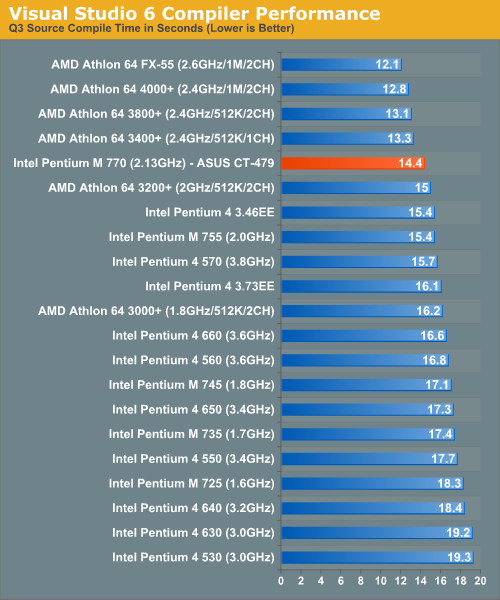
SPECviewperf 8
For our next set of professional application benchmarks, we turn to SPECviewperf 8. SPECviewperf is a collection of application traces taken from some of the most popular professional applications, and compiled together in a single set of benchmarks used to estimate performance in the various applications that the benchmark is used to model. With version 8, SPEC has significantly improved the quality of the benchmark, making it even more of a real world indicator of performance.We have included SPEC's official description of each one of the 8 tests in the suite.
The Pentium M doesn't excel in any of the SPECviewperf tests, but its performance is much more respectable with the ASUS solution, thanks to a more balanced memory bandwidth system.
3dsmax Viewset (3dsmax-03)
"The 3dsmax-03 viewset was created from traces of the graphics workload generated by 3ds max 3.1. To ensure a common comparison point, the OpenGL plug-in driver from Discreet was used during tracing.
The models for this viewset came from the SPECapc 3ds max 3.1 benchmark. Each model was measured with two different lighting models to reflect a range of potential 3ds max users. The high-complexity model uses five to seven positional lights as defined by the SPECapc benchmark and reflects how a high-end user would work with 3ds max. The medium-complexity lighting models use two positional lights, a more common lighting environment.
The viewset is based on a trace of the running application and includes all the state changes found during normal 3ds max operation. Immediate-mode OpenGL calls are used to transfer data to the graphics subsystem."
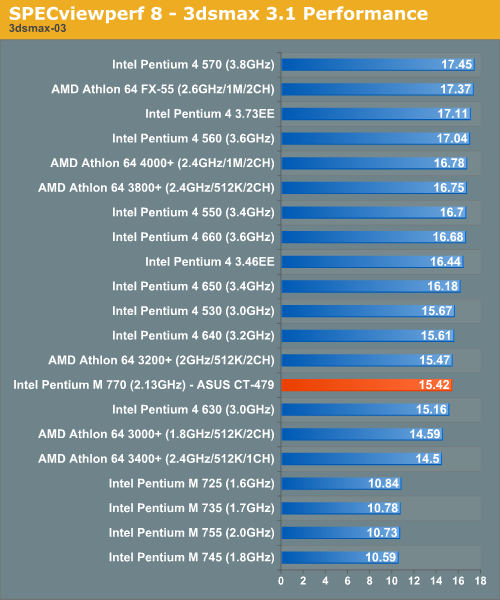
CATIA Viewset (catia-01)
"The catia-01 viewset was created from traces of the graphics workload generated by the CATIATM V5R12 application from Dassault Systems.
Three models are measured using various modes in CATIA. Phil Harris of LionHeart Solutions, developer of CATBench2003, supplied SPEC/GPC with the models used to measure the CATIA application. The models are courtesy of CATBench2003 and CATIA Community.
The car model contains more than two million points. SPECviewperf replicates the geometry represented by the smaller engine block and submarine models to increase complexity and decrease frame rates. After replication, these models contain 1.2 million vertices (engine block) and 1.8 million vertices (submarine).
State changes as made by the application are included throughout the rendering of the model, including matrix, material, light and line-stipple changes. All state changes are derived from a trace of the running application. The state changes put considerably more stress on graphics subsystems than the simple geometry dumps found in older SPECviewperf viewsets.
Mirroring the application, draw arrays are used for some tests and immediate mode used for others."
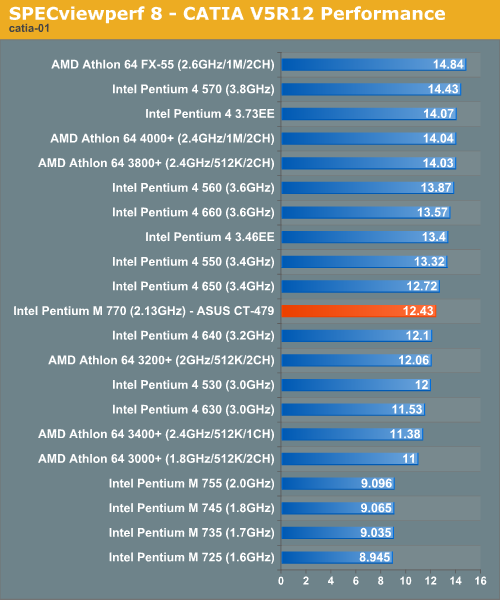
Lightscape Viewset (light-07)
"The light-07 viewset was created from traces of the graphics workload generated by the Lightscape Visualization System from Discreet Logic. Lightscape combines proprietary radiosity algorithms with a physically based lighting interface.
The most significant feature of Lightscape is its ability to simulate global illumination effects accurately by precalculating the diffuse energy distribution in an environment and storing the lighting distribution as part of the 3D model. The resulting lighting "mesh" can then be rapidly displayed."
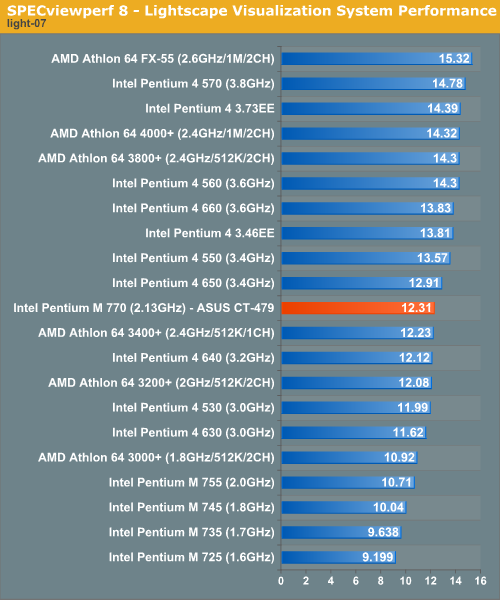
Maya Viewset (maya-01)
"The maya-01 viewset was created from traces of the graphics workload generated by the Maya V5 application from Alias.
The models used in the tests were contributed by artists at NVIDIA. Various modes in the Maya application are measured.
State changes as made by the application are included throughout the rendering of the model, including matrix, material, light and line-stipple changes. All state changes are derived from a trace of the running application. The state changes put considerably more stress on graphics subsystems than the simple geometry dumps found in older viewsets.
As in the Maya V5 application, array element is used to transfer data through the OpenGL API."
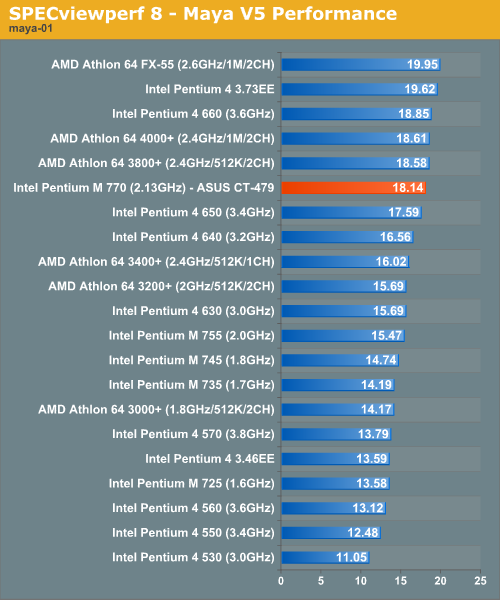
Pro/ENGINEER (proe-03)
"The proe-03 viewset was created from traces of the graphics workload generated by the Pro/ENGINEER 2001TM application from PTC.
Two models and three rendering modes are measured during the test. PTC contributed the models to SPEC for use in measurement of the Pro/ENGINEER application. The first of the models, the PTC World Car, represents a large-model workload composed of 3.9 to 5.9 million vertices. This model is measured in shaded, hidden-line removal, and wireframe modes. The wireframe workloads are measured both in normal and antialiased mode. The second model is a copier. It is a medium-sized model made up of 485,000 to 1.6 million vertices. Shaded and hidden-line-removal modes were measured for this model.
This viewset includes state changes as made by the application throughout the rendering of the model, including matrix, material, light and line-stipple changes. The PTC World Car shaded frames include more than 100MB of state and vertex information per frame. All state changes are derived from a trace of the running application. The state changes put considerably more stress on graphics subsystems than the simple geometry dumps found in older viewsets.
Mirroring the application, draw arrays are used for the shaded tests and immediate mode is used for the wireframe. The gradient background used by the Pro/E application is also included to better model the application workload."
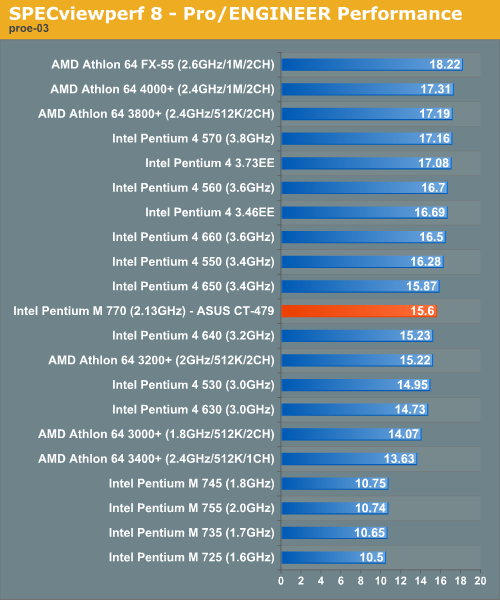
SolidWorks Viewset (sw-01)
"The sw-01 viewset was created from traces of the graphics workload generated by the Solidworks 2004 application from Dassault Systemes.
The model and workloads used were contributed by Solidworks as part of the SPECapc for SolidWorks 2004 benchmark.
State changes as made by the application are included throughout the rendering of the model, including matrix, material, light and line-stipple changes. All state changes are derived from a trace of the running application. The state changes put considerably more stress on graphics subsystems than the simple geometry dumps found in older viewsets.
Mirroring the application, draw arrays are used for some tests and immediate mode used for others."
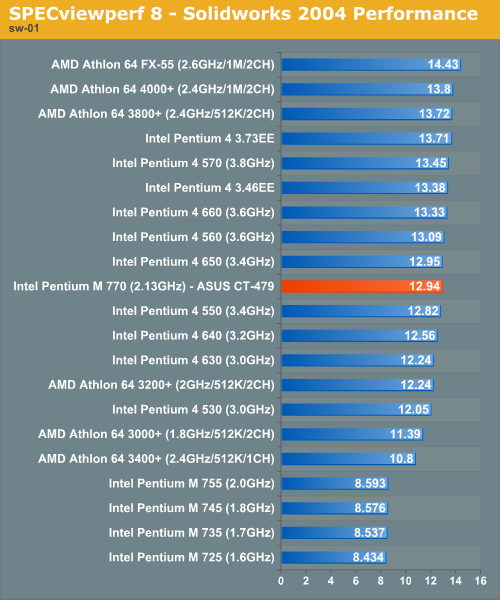
Unigraphics (ugs-04)
"The ugs-04 viewset was created from traces of the graphics workload generated by Unigraphics V17.
The engine model used was taken from the SPECapc for Unigraphics V17 application benchmark. Three rendering modes are measured: shaded, shaded with transparency, and wireframe. The wireframe workloads are measured both in normal and anti-alised mode. All tests are repeated twice, rotating once in the center of the screen, and then moving about the frame to measure clipping performance.
The viewset is based on a trace of the running application and includes all the state changes found during normal Unigraphics operation. As with the application, OpenGL display lists are used to transfer data to the graphics subsystem. Thousands of display lists of varying sizes go into generating each frame of the model.
To increase model size and complexity, SPECviewperf 8.0 replicates the model two times more than the previous ugs-03 test."
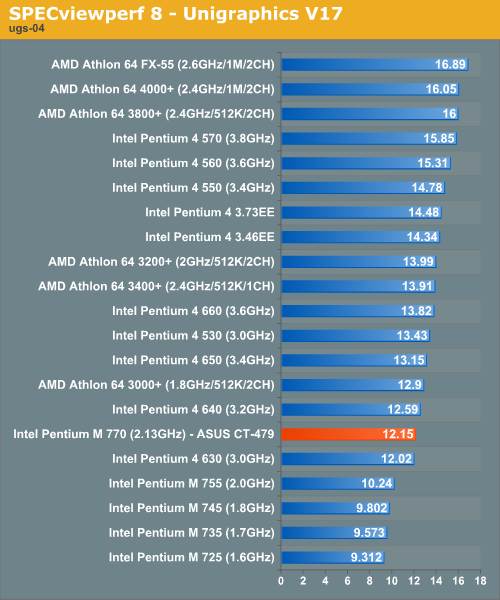










48 Comments
View All Comments
merkmal - Thursday, March 24, 2005 - link
I don't understand why there wasn't a direct comparison here between the i855 and the i865. It seems very un-anandtech like to go on and on about how this is such an improvment over the i855 setups and then not even show 2 of the same clocked processors in both setups to show if that really is the case. Testing a "faster" setup with a processor that is already known to be faster simply by the fact that it is clocked at stock speeds faster isn't a very good comparison or argument for better performance either.I understand the fact that lots of readers are interested in using a Pentium-M on the desktop and would like to know how it compares to other desktop processors, but I thought that was clear from the previous article on exactly that. This article should have been only Pentium-Ms in a variety of setups. It's easy to check back at the old article and see relatively how the new setup compares to the other desktop only processors.
I'm just very dissapointed in this article. I appauled you on the reviewing of the adapter, but think the comparisons drawn were just shoddy and un-thought out.
VIAN - Thursday, March 24, 2005 - link
Can't wait for Intel to do away with the P4 and step in with a suped-up PM.Or at least do away with the EE, market the PM as a multimedia chip and the P4 as a workstation chip.
kmmatney - Thursday, March 24, 2005 - link
NewEgg doesn't sell the 770 cpu, and it would be incredibly expensive if they did. Can you test the cheapest P-M, and see how it overclocks?PandaBear - Thursday, March 24, 2005 - link
Yeah PM is the way to go in the future. P4 architecture is getting way too inefficient and burn way too much power that it is not going to grow from where we are now. I am sure Intel is fully aware of this but keep it under the cover to avoid tanking the P4 sales. What would the customer think the PC they spend big bucks for is slower and hotter than a laptop CPU hacked from last generation technology, that would be a slap on the face.Anyhow, I still think A64 has better architecture for long term growth. Now if they come up with integrated North Bridge that has 20 PCIe lane in replacement of the HT port....
RockHydra11 - Thursday, March 24, 2005 - link
I don't understand the "desktop killer" thing...It never was intended for the desktop.It was centered to compete with anything else that was on the notebook platform, so Intel was not generating it to perform well against desktop processors, let alonre FLAGSHIP desktop processors. It is what it is, and that's that. Yonah is going to be the one centered toward real desktop performance.Mingon - Thursday, March 24, 2005 - link
Would have been nice to have run in both single and dual channel configs so as to see if the chip is bandwidth starved.68GTX - Thursday, March 24, 2005 - link
Looks like Legit reviews is currently testing with a new beta bios with voltage options."Part 2 is being updated... ASUS-USA sent me over a new BETA BIOS that is awesome. Fixes the performance issues and the voltage issues that were noted in the article... Take a look at the new voltages..."
http://forums.legitreviews.com/viewtopic.php?t=157...
Mangler - Thursday, March 24, 2005 - link
Legit Reviews also has this adapter reviewed today at: http://www.legitreviews.com/article.php?aid=181They compared an Intel 770 CPU on both the DFI 855GME-MGF motherboard and the ASUS P4P800SE for an apples to apples look. (i855GM versus i865PE)
They focus more on overclocking and use of the kit. A must read for any enthusiast.
Goi - Thursday, March 24, 2005 - link
#12, you can't say that tha Pentium M is based on old technology. There are many power saving techniques on the Pentium M that aren't implemented in the P4, both in the microarchitectural level, circuit level and logic level. The Pentium M is a hybrid between the P3 and the P4, but to say that it's closer to the P3, I'm not sure I agree with that. It does use executation units that are simialr to the P3's, but there are many areas where they are different, including the issue/control logic, which is a BIG part of microprocessors nowadays(and really, in the past decade or so).mrmorris - Thursday, March 24, 2005 - link
I'd like to point out that while the Pentium-M offer sub-desktop performance at worst, it does so with out heating up the room or requireing earplugs to dampen the fan noise! Therefore, as an office/coorporate workstation it fits perfect.